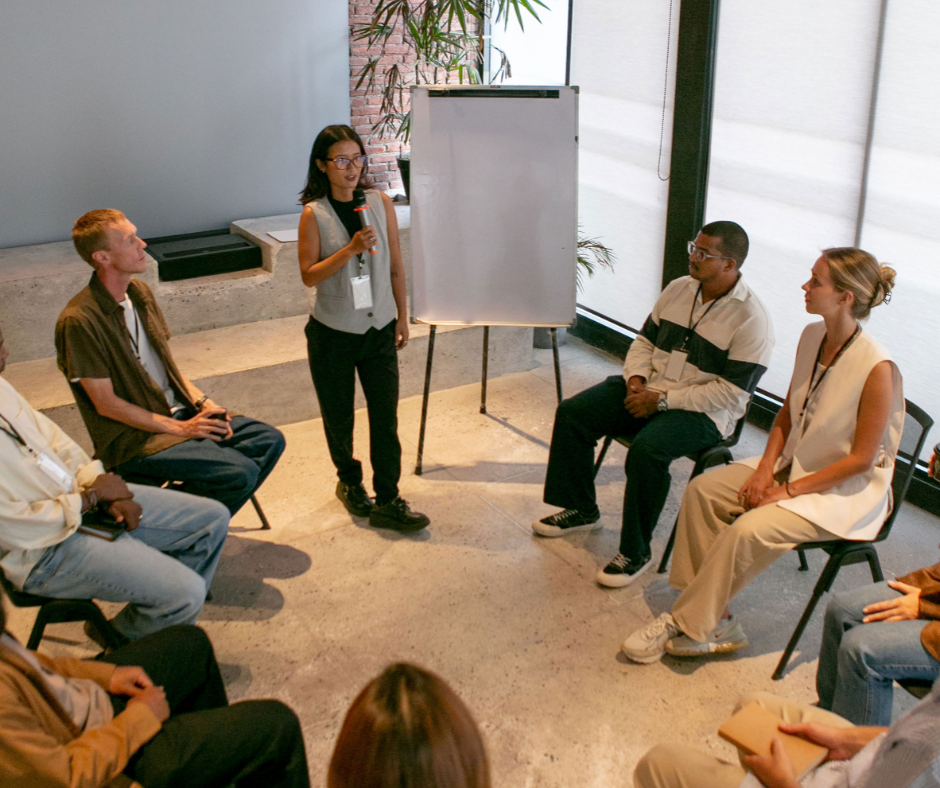
How to Nail Your End-of-Year Meeting (and 2024) with Confidence
Summary
End-of-year meetings are an opportunity to reflect on the past year, celebrate accomplishments, and plan for the year ahead. This guide offers actionable tips for women in creative fields to approach these meetings with confidence—whether as a boss or an employee. From preparing key metrics and revisiting feedback to navigating conversations with empathy and advocating for yourself, this article helps you make the most of your meeting while setting clear goals for the future.
Reflection Questions
- What accomplishments, both big and small, am I most proud of from the past year, and how did they contribute to my growth?
- What challenges did I face, and what valuable lessons or process improvements can I take into the upcoming year?
- How can I strengthen or nurture my key relationships and collaborations to foster mutual growth in the year ahead?
Journal Prompt
Take 10 minutes to write about the past year: What moments—big or small—felt like wins? What challenges helped you grow, and how did you overcome them? Finally, jot down three key goals you’re excited to focus on in the upcoming year.
End-of-year meetings are one of those rare chances to pause and take stock of where you’ve been and where you’re headed. For women in creative fields—whether you’re designing spaces, crafting stories, or creating art—it’s a moment to celebrate your wins, reflect on lessons learned, and lay the groundwork for an exciting year ahead. These meetings can feel overwhelming, especially when you’re balancing the demands of running a business or finishing up big projects, but they’re also a perfect opportunity to reset with purpose. This DesignDash guide will help you approach your meeting with clarity, confidence, and a sense of direction for what’s next.
Start by Reflecting on the Past Year with Purpose

Reflection is about honoring your creative journey. This is your perfect opportunity to recognize how far you’ve come, how much you’ve learned, and how you want to move forward. As a creative, your path isn’t always linear, and that’s okay.
By taking this time to reflect, you can head into the new year with intention and excitement, ready to tackle new challenges, foster meaningful relationships, and set goals for the upcoming year that truly align with your vision and values.
Celebrate the Big (and Small) Wins
Take a moment to celebrate the good stuff! Reflecting on your accomplishments, both the big milestones and the quieter, behind-the-scenes victories, sets the stage for a successful year-end meeting. Maybe you launched a new product line, landed a dream client, or mastered a tricky technique in your craft. These wins, no matter their size, represent progress and hard work.
Don’t forget to give a shout-out to your team or collaborators if their support helped you along the way—it’s a great way to build team spirit and boost morale. Acknowledging these achievements during your year-end meeting agenda sets a positive tone and reminds everyone of the collective achievements that make all the late nights and long hours worthwhile.
But Be Sure to Identify Lessons Learned from Setbacks

Challenges are inevitable, but they’re also where we grow. Whether it’s a product launch that didn’t go as planned, a missed deadline, or a design that didn’t resonate as expected, each setback offers valuable lessons.
During your end-of-year meeting, reflect on these moments and ask yourself: What worked, what didn’t, and what can be improved? Use this time to consider process improvements for the year ahead.
Frame these lessons as stepping stones, not failures. If you’re part of a team, encourage an open discussion about how challenges can shape your upcoming projects. This mindset turns obstacles into opportunities for growth and innovation.
Assess Collaborations and Key Connections
The relationships you nurture can shape your career as much as your skills and achievements. Look back on the past year and reflect on the connections that helped you move forward.
Did a colleague’s feedback inspire new ideas? Did a client relationship lead to exciting projects? These collaborations and moments of team building deserve to be acknowledged during your year-end meeting.
Take this time to assess not only what these relationships brought you but also how you contributed to them. Going into the new year, think about how you can foster these connections further and build bridges for future opportunities.
Top Tip: Create a Year-in-Review Worksheet
If reflecting feels overwhelming, a simple “Year in Review” worksheet can help you organize your thoughts during the planning process. Divide your thoughts into categories: accomplishments, challenges, relationships, and lessons learned.
Make it fun—add word clouds, doodles, or even a personal touch like photos of favorite projects. Include personal growth moments that added richness to your life. Using a tool like this not only prepares you for your year-end meeting but also provides clarity on where to focus your energy for next year’s goals.
Here’s How to Prepare for that End of the Year Meeting
Step 1: Gather Important Metrics and Examples of Your Work

Data tells a story, and for your year-end meeting, it’s time to make sure that story shines. Gather key metrics—like project budgets, client feedback, or sales data—that demonstrate your impact over the past year.
For interior designers, that could mean showcasing a successful redesign that came in under budget or pulling client testimonials that rave about your vision. If you’re a gallery owner or artist, track sales or attendance numbers from a show.
For makers, highlight popular product launches or custom commissions. Having this information at your fingertips not only builds your confidence but also shows your team leaders or collaborators that you’re fully prepared to discuss your contributions clearly and professionally.
Step 2: Revisit Feedback to Understand Others’ Perspectives
Feedback, whether formal or informal, is one of the most valuable tools for self-improvement. Take time before your year-end meeting to gather feedback you’ve received throughout the year. This could be a glowing review from a client, constructive notes from a peer, or even casual comments from your team members.
Understanding how others perceive your work provides insight into your strengths and areas for growth. This perspective helps you step into the meeting ready to discuss both what’s been successful and what could use refinement, setting a positive tone for the discussion.
Step 3: Highlight Strengths and Growth Areas

Think of your year-end meeting as a chance to tell the story of your professional journey. What are the strengths you want to emphasize, and where do you see room for growth? What are your key objectives for next year? Frame your narrative to highlight how you’ve contributed to the team’s accomplishments or moved the needle on company goals.
Maybe you spearheaded a process improvement, elevated a project’s design, or took the lead on a brainstorming session that shaped an upcoming project. Balancing confidence in your successes with humility about areas for development demonstrates thoughtfulness and leadership—whether you’re the boss or an employee.
Step 4: Write Down Three Key Points You Want to Communicate
Year-end meetings can be packed with discussion topics, so it’s crucial to stay focused. Write down three key points you want to communicate about your work and contributions.
These might align with agenda items such as your proudest accomplishment, a suggestion for next year’s goals, or a reflection on a team challenge you’re excited to improve upon. This preparation helps you stay on track during the meeting and ensures you leave no important detail unsaid.
Step 5: Rehearse Your Delivery to Build Confidence
Nerves can get the best of anyone, even seasoned professionals. One way to combat them is to rehearse what you plan to say. Practice articulating your key points out loud, ideally with a friend or in front of a mirror.
Pay attention to your tone and phrasing, ensuring your words come across as confident yet approachable. This small step can make a big difference, helping you feel calm and in control during the meeting.
Step 6: Remember that Confidence Comes from Preparation, Not Perfection

Finally, remember that the goal isn’t perfection but preparation. A successful year-end meeting isn’t about having all the answers but about showing you’re engaged, reflective, and ready to contribute.
By putting in the work ahead of time, you’ll step into the meeting with the confidence to communicate your value, celebrate progress, and focus on the future. Let go of the pressure to impress and instead focus on being authentic and intentional. Try to have a bit of fun, too.
Now It’s Time to Navigate that Conversation Like a Pro!
Instead of viewing your year-end meeting as a performance review, consider it a dialogue about the future. This is a chance to reflect on the good things from the past year, identify lessons learned, and align on goals for the upcoming year.
By reframing the conversation, you’ll leave the meeting feeling excited, inspired, and ready to move forward with intention.
If You’re the Boss: Start with Empathy

As a team leader, setting the right tone for a successful year-end meeting begins with empathy. Acknowledge the challenges your team has faced over the past year and recognize their collective achievements.
Whether your team hits key metrics or your designers pull off a last-minute project, showing genuine gratitude for their hard work builds team spirit and boosts morale. This sets a positive tone for the meeting and makes employees feel valued, which is essential for fostering teamwork and creating a strong foundation for the upcoming year.
If You’re the Boss: Provide Constructive Feedback
Delivering feedback during team meetings requires balance, kindness, and forethought. Frame it as a growth opportunity rather than a critique. Highlight where your team excelled—whether that’s in meeting company goals or implementing process improvements—and then transition to areas that could benefit from a fresh approach or new ideas.
For example, instead of saying, “This didn’t work,” try, “Here’s an area where we can experiment with a new strategy next year.” This approach not only maintains a positive tone but also encourages open discussion and innovative thinking. Remember, you want to end the year on a high note.
If You’re the Boss: Empower Your Team
Empowerment is the secret ingredient to building a motivated team. During the meeting, ask your team members what tools, resources, or support they need to thrive in the upcoming year. Whether it’s updated software, clearer communication, or more brainstorming sessions, giving your team a voice shows that their input matters.
This is also a great moment to highlight upcoming projects and set the stage for a shared vision of the future. Empowering your team creates an environment where everyone feels invested in the company’s success.
If You’re an Employee: Advocate for Yourself

Your year-end meeting is a perfect opportunity to celebrate your contributions and advocate for yourself. Share examples of your achievements—like improving a key process or completing a high-profile project—and don’t hesitate to take credit where it’s due.
Don’t brag; communicate your value in a way that aligns with the company’s goals. Come prepared with specific examples to make your case confidently and effectively.
If You’re an Employee: Be Proactive
Take the lead in the conversation by sharing your ideas for company growth and your role in achieving it. For instance, if you’ve noticed an area where process improvements could make a difference, bring it up as a constructive suggestion.
Being proactive not only shows your engagement but also positions you as a forward-thinking team member who’s ready to tackle the challenges of the year ahead.
Fuel your creative fire & be a part of a supportive community that values how you love to live.
subscribe to our newsletter
*please check your Spam folder for the latest DesignDash Magazine issue immediately after subscription

If You’re an Employee: Seek Clarity
Don’t leave the meeting without understanding what’s expected of you in the upcoming year. Ask thoughtful questions about next year’s goals, upcoming projects, and your role in achieving them.
This will ensure that you and your team leaders are on the same page and provide you with a clear roadmap to follow. It’s also a great time to collect feedback on your performance and identify areas for growth.
Actionable Framework: The 3 C’s
To ensure a productive conversation, focus on the three Cs: Connect, Communicate, and Collaborate. First, connect by building rapport. Start the meeting with a fun way to break the ice, like a quick team quiz or a shout-out to a colleague’s recent success.
Next, communicate your key points clearly, whether you’re presenting ideas for the year ahead or sharing your progress over the past year. Finally, collaborate by discussing ideas for mutual growth, fostering an open discussion that sparks creativity and innovation.
Final Thoughts: Celebrate Your Team and Embrace Opportunities for Growth in 2025

Whether you gather your sales team or talk with your senior designers, hosting a productive end-of-year meeting shouldn’t just be another item on your to-do list. Instead, you should see it as a chance to connect with your team, reflect on the collective achievements of the past year, and plan for an exciting and intentional future.
Let this year-end meeting be the springboard for new ideas, meaningful goals, and a future filled with creativity and growth. Go into it with intention, celebrate the good stuff, and leave feeling ready to tackle your next chapter with excitement and purpose.








